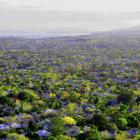For the second time in just a few years the ancient Kauri Tree in West Auckland has become the showplace of a passionate debate and battle over the significance of native trees in New Zealand’s urban environment. Two years ago, architects bought a piece of land in Titirangi and designed a plan for two houses. In that, they decided to cut two native trees: a kauri tree (Agathis australis) estimated to be circa 800 years old and a rimu (Dacrydium cupressinum), probably around 500 years old—however, the age of the trees is also a matter of debate.

View over Auckland from Mount Eden volcano
View over Auckland from Mount Eden volcano
Photo credit: Jeannine-Madeleine Fischer, 2012.
 This work is licensed under a Creative Commons Attribution-NonCommercial-ShareAlike 4.0 International License.
This work is licensed under a Creative Commons Attribution-NonCommercial-ShareAlike 4.0 International License.
Unlike current discussions about rights of nature as such, this controversy is about the symbolic value of “native” species in reference to a larger frame of national identity. New Zealand lost a remarkable amount of its endemic biodiversity following human settlement: by 1840 more than 50 percent of the bush had already been cleared, while statistics from 2013 show that the coverage has continued to be reduced down to around 30 percent of pre-settlement levels. In public discussions, native trees are conceived of as needing protection because they represent the country. I argue that the negotiation of urban nature goes beyond the dichotomy of tradition versus modernity or nature versus city; it is a battle against the loss of nativity as a basis for identity and the feeling of belonging. Tree activists fight for the recognition of the particular meaning of native trees in an urban environment.

A kauri tree
A kauri tree
Click here to view Google Image source.

This work is licensed as a Public Domain Dedication.
The kauri tree is one of New Zealand’s oldest native species, endangered by the kauri dieback caused by the pathogen Phytophthora agathidicida, and under particular protection. Evoking a past of lush rainforests and native bush, and simultaneously gesturing towards a future of preservation, the debate around saving trees uses arguments about responsibility towards both the past and future generations. The kauri tree is understood as a symbol of national belonging with great emotional resonance. Neighbors start crying about felled trees, report that they feel the trees’ pain, and get angry about worldviews that deny the rights and sensations of “their” nature. The opposite of “their” nature is clearly defined: invasive species are classified as weeds, pests, and enemies that threaten the natives and must therefore be combatted. The paradigm of nativity classifies nature into categories of “right” and “wrong” and reflects local ideals of the urban environment. The geographical setting of New Zealand and the feeling of isolation strengthen the idea of creating the “100% pure” space envisioned by the tourist campaign. Since Auckland is steadily growing and densely populated, call to create and preserve native space is becoming more urgent.
As soon as the community in Titirangi learned about the plans of the architects, they organized a local protest. In March 2014 a tree sitter climbed the old kauri and stayed for three days until the architects promised in an open letter to save the tree. For nearly nine months silence descended around the case, until by chance a neighbor noticed the noise of chainsaws on the property and intervened. The contractors charged with cutting the kauri immediately stopped their work, pretending not to have been informed properly and not wanting to get a bad reputation from being involved in this issue. As the destiny of the tree remained unclear, a second tree sitter climbed the kauri for twelve days—this time it was not a promise that made him stop, an attack on the kauri itself: eight men ring-barked the tree in an attempt to kill it; headlines in social media referred to the case with catchphrases as the “Kauri massacre.” The tree sitter came down to provide first aid to the damaged tree and, finally, handed himself over to the police. He was charged with trespassing and sentenced to pay a remarkable fine; meanwhile the group of men who attacked the tree remained unknown.
How to cite
Fischer, Jeannine-Madeleine. “The Kauri Case—Native Nature and National Identity in Titirangi, New Zealand.” Environment & Society Portal, Arcadia (Summer 2016), no. 11. Rachel Carson Center for Environment and Society. https://doi.org/10.5282/rcc/7629.
ISSN 2199-3408
Environment & Society Portal, Arcadia
 This work is licensed under a Creative Commons Attribution-NonCommercial-ShareAlike 4.0 International License.
This work is licensed under a Creative Commons Attribution-NonCommercial-ShareAlike 4.0 International License.
2016 Jeannine-Madeleine Fischer
This refers only to the text and does not include any image rights.
Please click on an image to view its individual rights status.
- Heynen, Nik, Maria Kaika, and Erik Swyngedouw. In the Nature of Cities. Urban Political Ecology and the Politics of Urban Metabolism. New York: Routledge, 2006.
- Kaika, Maria. City of Flows. Modernity, Nature, and the City. New York: Routledge, 2005.
- Marris, Emma. Rambunctious Garden. Saving Nature in a Post-Wild World. New York: Bloomsbury, 2013.
- Winter, Katharina. Ansichtssache Stadtnatur. Zwischennutzungen und Naturverständnisse. Berlin: Transcript-Verlag, 2015.








